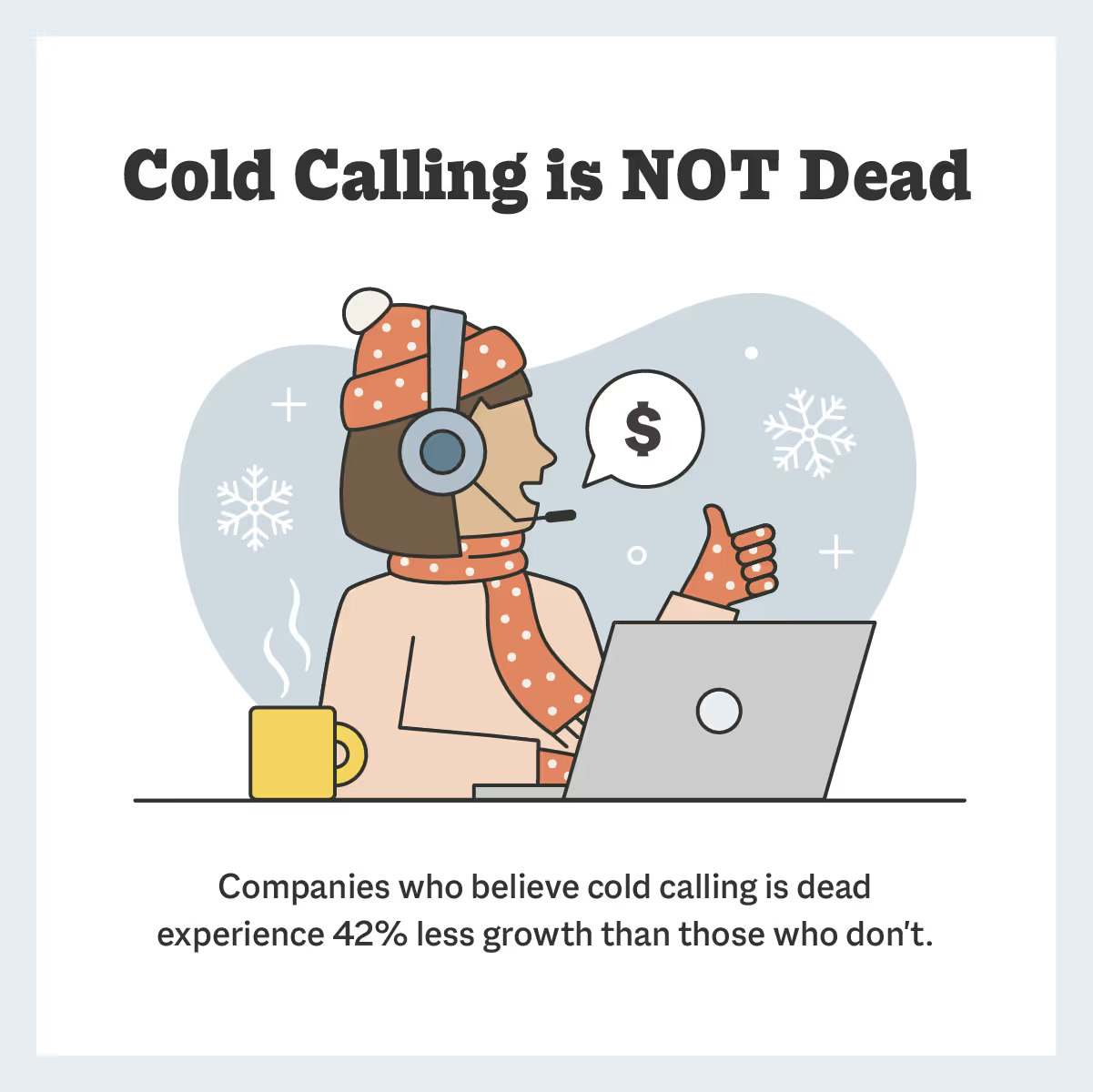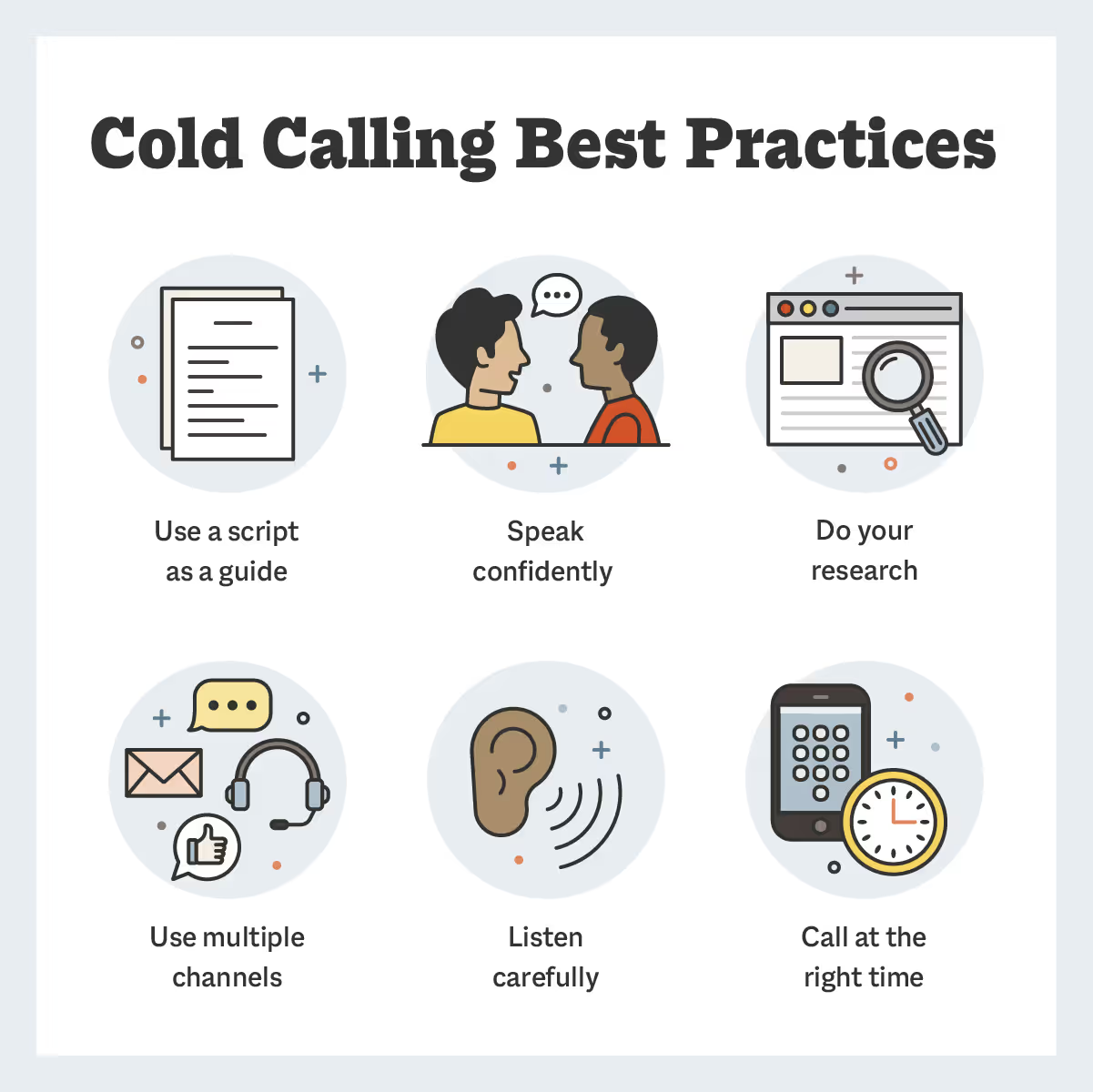Is Cold Calling Dead? Tips and Alternatives For Success
Is Cold Calling Dead? Tips and Alternatives For Success

Cold calling often gets a bad reputation. Many people assume that everyone is busy, and nobody likes to have their bustling day disrupted by strangers trying to sell them something. That’s why there are people who believe that cold calling is dead.
While there may be truth behind those assumptions, cold calling is most definitely not dead. However, you must ensure you are implementing the correct practices to make your cold-call outreach campaigns successful.
In this article, we’ll go over why cold calling isn’t dead, best practices for cold calling success, and alternatives to cold calling so your sales team can have a wider range of successful lead generation strategies to draw from.

Is cold calling dead?
No — cold calling is not dead.
So why do people claim it is? Many people assume this because of the rise of business tech trends like social networking and automated email marketing, which have proven to be useful tools for outreach initiatives.
While this is true (and a great addition to implement into your outreach strategy), cold calling is still an essential component of every lead generating strategy. Don’t believe us? Check out some of these cold calling statistics that showcase just how alive this outreach strategy really is:
- Companies who believed cold calling was no longer effective experienced 42% less growth than those that did not.
- 57% of C-level and VP buyers prefer to be contacted by phone.
- Unexpected cold calls prompted 75% of prospects from various industries to attend an event or schedule a meeting.
- Sales reps can boost their conversion rate by 70% by making only a few more cold call attempts.
- 69% of B2B buyers accepted a cold call from new providers.
Cold calling best practices
Every firm, whether it be an established corporation or a growing start-up, depends on cold calling to generate income. And because of this, cold calling is far from being obsolete; in fact, it only recently began to change.
You must put best practices into action if you want your cold calls to be successful and generate more leads. Fortunately, we have some excellent insight into what those best techniques are.

Figure out an ideal time to call
First and foremost, you’ll want to catch your leads at the perfect time. If you are planning to call a prospect first thing Monday morning or on a Friday afternoon, you’re just begging to be put on their blocked caller list.
Tuesday, Wednesday, and Thursday are the optimal days to make cold calls, with Wednesday being the best. The best time to make a cold call is between 4:00 and 5:00 p.m., when prospects are winding down for the day.
Be sure to consider your prospect’s time zone before picking up the phone to perform a cold call.
Do your prospect research
Whether your goal for cold calling is to set an appointment or offer a special deal to a prospective lead, you’ll need to do thorough research to have a true understanding of your target clientele’s wants and needs to earn their attention, and in turn, their business.
Despite the fact that it might seem obvious, 82% of B2B decision makers believe that sales professionals are unprepared prior to making a cold call. That’s why you need to spend a good amount of time analyzing your ideal customer profile to determine who you should be targeting.
Discover the current situation of a potential lead's company, including any difficulties or achievements they may have faced lately. Recognize every detail so you can create a pitch that is uniquely suited to them.
Use a script as a guide
Once you have a good idea of the wants and needs of your ideal customer, you can draft an effective cold call script. You can reference our outbound call script examples to help you through any cold calling situation, but make sure you use scripts as a guide rather than something you regurgitate word for word. Otherwise, you could sound robotic and inauthentic, limiting your ability to make a personal connection.
An efficient phone script consists of various components. Even though the general call flow should be consistent between calls, the precise wording of each section can vary depending on the circumstances.
Speak with confidence
Your pitch is crucial, but so is the way you present it. When making a cold call, you need to pay attention to how your voice sounds. There shouldn't even be a touch of monotone; instead, your voice should be full of enthusiasm. As a result, your offerings will sound more enticing.
Listen carefully
While on a call, use active listening techniques to avoid having the caller repeat a response they have already given. Ask the correct probing questions to listen more than you talk, as successful cold calls frequently have a 55:45 talk-to-listen ratio.
Use a multi-channel strategy
One of the best practices for cold calling in today’s world is to use a multi-channel strategy. This means you contact a lead using a variety of methods like social media, email, and live chat to warm up a cold lead before the first phone call.
Although this technically turns a cold call into a warm call, with the abundance of digital communication at our disposal, it would be foolish not to use these tactics for contacting potential clients — and other companies are recognizing this. In fact, 51% of businesses use at least eight different channels to interact with their customers.
Even if you send a simple email to a potential client and don't hear back, by the time you call them, they will already be familiar with you and may appreciate you calling to follow up.
10 Alternatives to cold calling
In the past, making a cold call was one of the finest — and only — prospecting strategies salespeople could use. Nowadays, a variety of other effective outreach methods have emerged.
Although it would be naive to claim that cold calling is never successful, beneficial, or required, it is essential to improve the other aspects of your prospecting plan so that it’s not your sole approach. Check out these other outreach methods to pair with your cold calls so you can level-up and diversify your lead generation strategy.
1. Email outreach
Email outreach is probably one of the best outreach tools to supplement with cold calling. In fact, cold emails are preferred by 80% of business purchasers over cold calls.
Cold calls can feel intrusive and may even evoke anxiety in some people. So a solid email is a great first approach before giving a call. This way, prospects have an idea of who you are and what your business has to offer.
The key with successful cold emailing is to capture their attention with a solid subject line and opening sentence. Make sure you add some personalization and provide the value of your offerings in a short and to-the-point message. You want to ensure your email doesn’t get lost in the shuffle.
2. Turn to social media
Social media is a great way to find and connect with potential sales leads as well as expand your network. If you have a solid social media plan in place, you can get quality leads with little time investment. In fact, a report by Social Media Examiner found that 66% of marketers were able to create new leads with just six hours per week on social media.
With over 80% of B2B leads coming from LinkedIn, it's one of the finest places for B2B businesses to invest their time. But that doesn't imply you should put restrictions on yourself. Increase the visibility of your brand and company on additional social media platforms that are appropriate for your industry, such as Facebook for Business, Twitter, TikTok, Instagram, and others.
3. Track web visitors’ behavior
By tracking the behavior of your website visitors and assigning the appropriate lead score, you’ll be able to determine an opportune moment to reach out with a call. Hotjar and FullStory are two excellent tools for behavior analysis that can be used to start tracking website behavior.
Examine the pages a lead visits and the steps they take on your website. It's a solid indication that you should get in touch if they are requesting demos or signing up for upcoming webinars.
However, if a lead is only looking at career pages, it may be a sign that they aren't interested in becoming a client and are only looking for job opportunities. In this case, you shouldn't waste your time contacting them.
4. Ask for referrals
Another great way to find leads is through referrals. Since they've previously made a purchase from you, satisfied customers are typically glad to recommend your goods or services. Don’t be afraid to ask them for a referral, and be as detailed as you can in your request. For example:
“Do you know any companies of X size in [industry] who struggle with [challenge]?”
As a result, your client will most likely think of a name right away, or at least get back to you on the matter. Even if your referrer doesn’t reach out to that person on your behalf, you’ll be able to mention their name during your cold call so that you have your foot in the door.
5. Get more positive reviews
Earning positive client reviews is imperative to any business. In fact, 92% of B2B buyers are more likely to make a purchase after reading a reputable review. Not only that, but receiving just 50 favorable reviews result in a 4.6% increase in conversions.
Leaving reviews isn’t always top of mind for clients, so make sure you have a procedure put in place to encourage favorable feedback. 68% of customers will submit a review if requested, so make sure you’re asking your customers to post a review.
6. Start blogging
Writing blogs is a great way to earn traffic to your website and increase your web presence. The majority of clients do their homework before contacting a company, so creating a web presence to help you connect with these leads is a great inbound strategy.
In fact, content marketing produces more leads than conventional marketing techniques, according to 93% of B2B organizations. Companies are able to enter the research stage of their sales leads by producing pertinent, interactive, and interesting content. This helps to increase traffic to the company's website and the appropriate landing pages.
After these leads read your content, you’ll be the one they turn to when they want to find out more information or make a purchase.
7. Host and attend events
A wonderful approach to spread the word about your small business and find more leads is by hosting or taking part in events. Events like networking meet-ups, industry conferences, webinars, or classes could be good places to generate leads.
Make sure you have a way of creating and gathering leads when you attend events. This might involve collecting names for a raffle, providing event attendees with a discount, showing demonstrations, or exchanging business cards.
8. Outreach marketing
Outreach marketing is a great marketing tactic businesses are starting to implement in order to boost brand awareness and promote their offerings.
Since customers prefer to trust media messaging from influencers, bloggers, or other brands they've previously done business with more than standard advertising or owned media, this marketing tactic is particularly effective.
In fact, 83% of customers trust digital word of mouth more than content made by advertising themselves.
Influencers can be found on every channel. These people help startups reach a wider audience. Additionally, they can aid in audience interaction and offer the necessary social evidence for customers to trust your business.
9. Continuously follow up with warm leads
Even if you’ve been rejected before, you should never stop nurturing your leads.
You've probably gotten in touch with a few businesses who were unwilling to work with you at the time, but prospects' circumstances are constantly shifting. Due to a larger budget, your services may now meet their demands, or your contact may have been moved to a new company or department where your solution is needed.
These potential customers are already aware of the services provided by your company, so check in with them every four to six months to see if anything has changed regarding their priorities, problems, goals, or preferences.
This helps you go beyond your initial follow-up and stay in the prospect's mind.
10. Create interesting content
Writing blogs and posting on social media is an excellent approach to lead generation, but you should also make unique, engaging, and interactive content to engage your prospects.
You may, for instance, create videos that offer advice on how to overcome a typical challenge in your industry. At the end, let the audience know you're willing to provide them with specific recommendations on the subject if they'd like. You could also conduct original data studies on a relevant trend happening in your industry to really capture a lead’s attention and make them want to learn more.
Make sure you share these pieces of content on your social media platforms and website.
Smith.ai virtual receptionists can take on all your outreach needs
Cold calling is not dead. It's a tried-and-true strategy that can still be effective as long as you use the right methods and pair it with other forms of outreach.
To help you make the most out of your cold calling approach, leverage our virtual receptionists for outreach campaigns. We specialize in managing your sales calls (warm and cold), appointment setting, and lead intake and qualification, so you can concentrate more on securing new business from qualified prospects and servicing existing clients, all activities that will generate revenue for your company.
Book a free consultation to learn how our 24/7 professional receptionists can help you streamline your lead qualification process and win new business.
Sources: Zippia | Crunchbase | ZoomInfo 1, 2| Rain Group | Social Media Examiner | G2 | BigCommerce | Qualtrics | Marketo | Pressfarm
Take the faster path to growth. Get Smith.ai today.
Key Areas to Explore
Technical Implementation Terms
Voice user interface (VUl) design
Speech recognition integration
Text-to-speech optimization
API connectivity and webhooks
Real-time data synchronization

Your submission has been received!














.svg)



